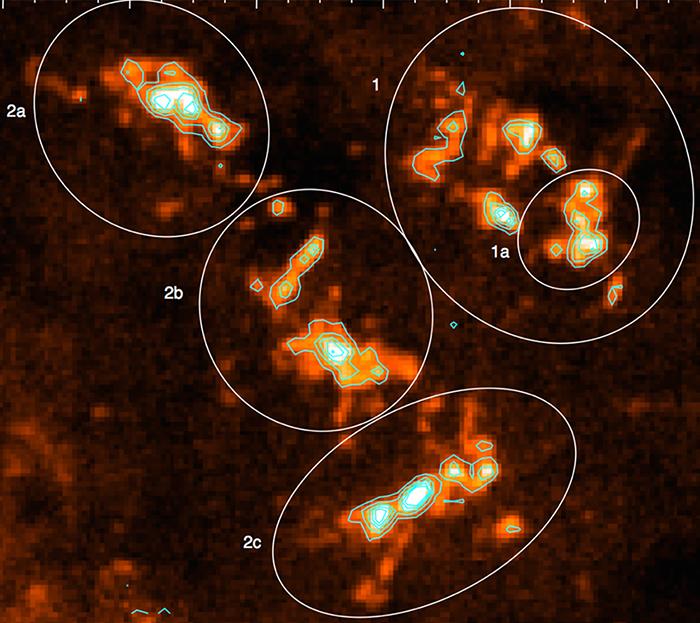Astronomers take first, high-resolution look at huge star-forming region of Milky Way

This image from a radio telescope shows a huge star-forming region of the outer Milky Way galaxy. The ovals identify the main subdivisions of the region's molecular cloud, including the smaller 1a, which is very efficient at producing stars. Image courtesy of Charles Kerton/Iowa State University
“This region is behind a nearby cloud of dust and gas,” said Charles Kerton, an associate professor of physics and astronomy at Iowa State University and a member of the study team. “The cloud blocks the light and so we have to use infrared or radio observations to study it.”
The Milky Way region is called CTB 102. It's about 14,000 light years from Earth. It's classified as an HII region, meaning it contains clouds of ionized – charged – hydrogen atoms. And, because of its distance from Earth and the dust and gas in between, it has been difficult to study.
And so, “this region has been very poorly mapped out,” Kerton said.
The astronomers describe their first draft of a new, higher-resolution map for the region in a paper recently accepted for publication in the Astrophysical Journal. Lead authors are Sung-ju Kang, a staff scientist at the Korea Astronomy and Space Science Institute and a former graduate student at Iowa State University; and Brandon Marshall, a former Iowa State graduate student who has accepted a faculty position at the University of Nebraska at Kearney.
Other co-authors are Kerton and Youngsik Kim, Minho Choi and Miju Kang, all of the Korea Astronomy and Space Science Institute. Kim is also with the Daejeon Observatory in South Korea.
Kerton said the astronomers used a newly commissioned radio telescope at the Taeduk Radio Astronomy Observatory in South Korea to take high resolution, carbon monoxide observations of the galactic region's molecular clouds.
“That tells us the mass and structure of the material in the interstellar medium there,” Kerton said.
The astronomers also compared their radio observations with existing infrared data from the Wide-?eld Infrared Survey Explorer and the Two Micron All Sky Survey. The infrared data allowed them to classify young stars forming within the region's molecular clouds.
The data yield three major observations, the astronomers report in their paper.
First, the astronomers used radio data to describe the physical structure and characteristics of the region's newly mapped molecular clouds – they're fairly large, about 180 light years across with a mass equal to about 100,000 masses of our sun. Next, they used infrared data to determine the young stellar content within the clouds. And finally, they combined the two data streams to study the efficiency of star formation within the galactic region.
They report the star formation efficiency of the entire CTB 102 region is about 5% to 10%, similar to other giant molecular clouds within the galaxy. But, they found one subregion of the clouds with a star formation efficiency of 17% to 37% (depending on how the mass of the subregion is calculated). That's much higher than would be expected for a subregion of its size. They speculate the subregion is the site of a massive cluster of young, developing stars embedded in the molecular cloud.
Why all the star formation in that one subregion? Kerton says that's a question for further study. Maybe, he said, there's something special about the interstellar material in that subregion, which is next to the massive HII region.
“This is our first look at all of this,” Kerton said. “The older data were just a few dots, a few pixels. We couldn't isolate this relatively small region of the galaxy.”
But now they could – with the help of the new South Korean radio observatory.
The study's high-resolution observations, Kerton said, “are also a demonstration that the telescope is ideal for studying similar regions in our galaxy – there are many other potential targets.”
Media Contact
More Information:
https://www.news.iastate.edu/news/2019/04/15/firstlookAll latest news from the category: Physics and Astronomy
This area deals with the fundamental laws and building blocks of nature and how they interact, the properties and the behavior of matter, and research into space and time and their structures.
innovations-report provides in-depth reports and articles on subjects such as astrophysics, laser technologies, nuclear, quantum, particle and solid-state physics, nanotechnologies, planetary research and findings (Mars, Venus) and developments related to the Hubble Telescope.
Newest articles

NASA: Mystery of life’s handedness deepens
The mystery of why life uses molecules with specific orientations has deepened with a NASA-funded discovery that RNA — a key molecule thought to have potentially held the instructions for…

What are the effects of historic lithium mining on water quality?
Study reveals low levels of common contaminants but high levels of other elements in waters associated with an abandoned lithium mine. Lithium ore and mining waste from a historic lithium…

Quantum-inspired design boosts efficiency of heat-to-electricity conversion
Rice engineers take unconventional route to improving thermophotovoltaic systems. Researchers at Rice University have found a new way to improve a key element of thermophotovoltaic (TPV) systems, which convert heat…



